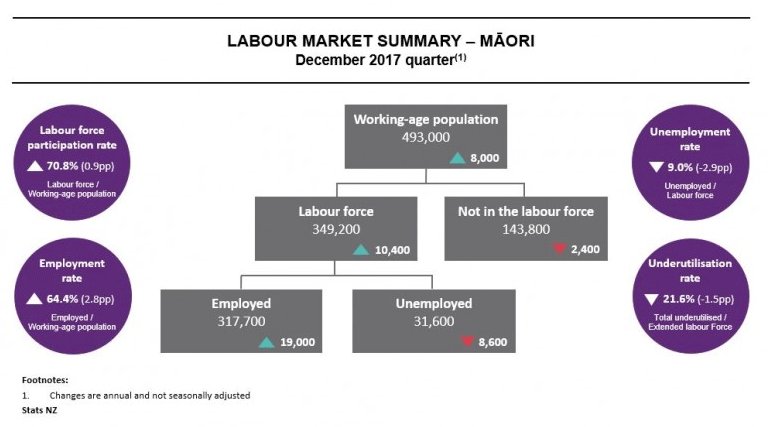Māori unemployment rate at nine-year low, but twice NZ rate
In the year to the December 2017 quarter, the
unemployment rate for Māori fell to a nine-year low, at the
same time as 19,000 more Māori, especially rangatahi (young
people), moved into work, Stats NZ said today.
The unemployment rate for Māori fell to 9.0 percent, compared with 11.9 percent a year ago. This is the lowest Māori unemployment rate since the December 2008 quarter; however, unemployment for Maori is double the national rate.
In the December 2017 year, the number of Māori unemployed fell 8,600 (down 21.4 percent). Fewer Māori men were unemployed (down 6,300), while the number of unemployed Māori women also dropped (down 2,300). The decrease in unemployed Māori was mainly from those aged 20–29 years, which contributed two-thirds of the decrease.
The underutilisation rate for Māori fell to 21.6 percent, from 23.1 percent a year ago. By comparison, the underutilisation rate for New Zealand overall is 12.1 percent.
“Just over 80,000 Māori are potential jobseekers, looking for more hours, or unemployed. Together, unemployment and underutilisation provide a broader picture of people wanting more work,” labour market and household statistics senior manager Jason Attewell said.
The proportion of the Māori working-age population employed is up to a new high of 64.4 percent, the highest since the series began a decade ago. This compares with a year ago when the employment rate was 61.6 percent.
More than half of the increase in employment came from Māori aged 15–24 years. This contributed to the Māori rangatahi not in employment, education or training (NEET) rate falling to 16.6 percent, down from 21.1 percent a year ago. The overall NEET rate for New Zealand was 11.9 percent.
“This means that the proportion of young Māori
not earning or learning is at the lowest level in 10
years”, Mr Attewell said. “Five in every six Māori
rangatahi aged 15–24 years are in some form of education,
training, or work.”



 Gordon Campbell: On The Government’s Latest Ferries Scam
Gordon Campbell: On The Government’s Latest Ferries Scam RNZRSA: RNZRSA Supports Willie Apiata VC's Stand To Drive Change To Veterans’ Support Act
RNZRSA: RNZRSA Supports Willie Apiata VC's Stand To Drive Change To Veterans’ Support Act Diane McCarthy - LDR: War Hero Willie Apiata Entrusts MP With Victoria Cross Medal
Diane McCarthy - LDR: War Hero Willie Apiata Entrusts MP With Victoria Cross Medal PSA: Disappointing Govt Attack On Diversity, Inclusion In Public Service
PSA: Disappointing Govt Attack On Diversity, Inclusion In Public Service NZ Labour Party: Govt Health And Safety Changes Put Workers At Risk
NZ Labour Party: Govt Health And Safety Changes Put Workers At Risk Amnesty International Aotearoa New Zealand: Democracy At Risk
Amnesty International Aotearoa New Zealand: Democracy At Risk Walk Without Fear Trust: New Sentencing Reforms Aimed At Restoring Public Safety Welcomed
Walk Without Fear Trust: New Sentencing Reforms Aimed At Restoring Public Safety Welcomed


